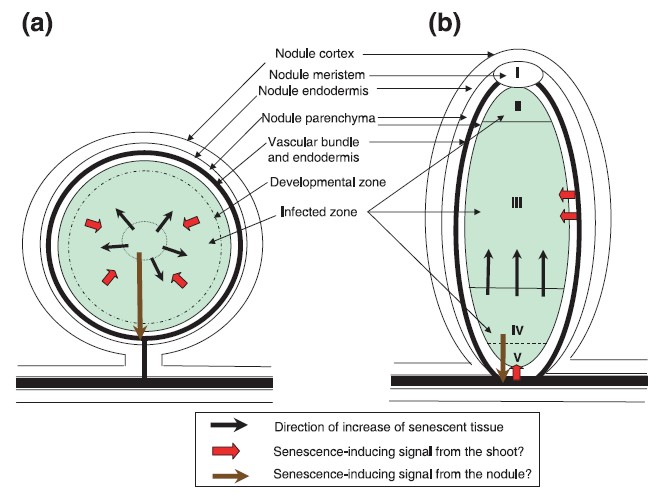博文
无限和有限根瘤(indeterminate and indeterminate nodules)
|||
无限根瘤(indeterminate nodules,或称为非定型根瘤)和有限根瘤(determinate nodules,或称为定型根瘤)示意图

摘自:
http://onlinelibrary.wiley.com/doi/10.1111/j.1469-8137.2004.01285.x/pdf
Determinate nodules are found on certain tribes of tropical legume such as those of the genera Glycine (soybean), Phaseolus (common bean), and Vigna. and on some temperate legumes such as Lotus. These determinate nodules lose meristematic activity shortly after initiation, thus growth is due to cell expansion resulting in mature nodules which are spherical in shape. Another types of determinate nodule is found in a wide range of herbs, shrubs and trees, such as Arachis (peanut). These are always associated with the axils of lateral or adventitious roots and are formed following infection via cracks where these roots emerge and not using root hairs. Their internal structure is quite different from those of the soybean type of nodule.
Indeterminate nodules are found in the majority of legumes from all three sub-families, whether in temperate regions or in the tropics. They can be seen in papilioinoid legumes such as Pisum (pea), Medicago (alfalfa), Trifolium (clover), and Vicia (vetch) and all mimosoid legumes such as acacias (mimosas), the few nodulated caesalpinioid legumes such as partridge pea They earned the name "indeterminate" because they maintain an active apical meristem that produces new cells for growth over the life of the nodule. This results in the nodule having a generally cylindrical shape, which may be extensively branched.[8] Because they are actively growing, indeterminate nodules manifest zones which demarcate different stages of development/symbiosis:
Zone I—the active meristem. This is where new nodule tissue is formed which will later differentiate into the other zones of the nodule.Zone II—the infection zone. This zone is permeated with infection threads full of bacteria. The plant cells are larger than in the previous zone and cell division is halted.Interzone II–III—Here the bacteria have entered the plant cells, which contain amyloplasts. They elongate and begin terminally differentiating into symbiotic, nitrogen-fixing bacteroids.Zone III—the nitrogen fixation zone. Each cell in this zone contains a large, central vacuole and the cytoplasm is filled with fully differentiated bacteroids which are actively fixing nitrogen. The plant provides these cells with leghemoglobin, resulting in a distinct pink color.Zone IV—the senescent zone. Here plant cells and their bacteroid contents are being degraded. The breakdown of the heme component of leghemoglobin results in a visible greening at the base of the nodule. This is the most widely studied type of nodule, but the details are quite different in nodules of peanut and relatives and some other important crops such as lupins where the nodule is formed following direct infection of rhizobia through the epidermis and where infection threads are never formed. Nodules grow around the root, forming a collar-like structure. In these nodules and in the peanut type the central infected tissue is uniform, lacking the uninfected ells seen in nodules of soybean and many indeterminate types such as peas and clovers.
上面的英文来自:https://en.wikipedia.org/wiki/Root_nodule
https://blog.sciencenet.cn/blog-3533-798406.html
上一篇:全基因组测序将成为细菌分类必须做的一项指征
下一篇:基因组比较表明MAFF303099与Mesorhizobium huakuii 7653R同种
